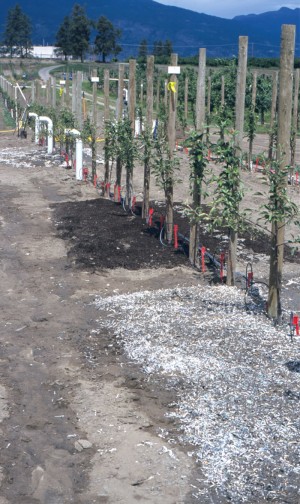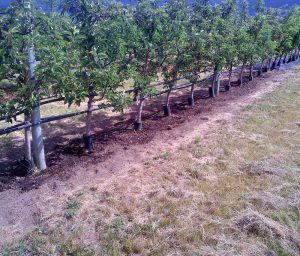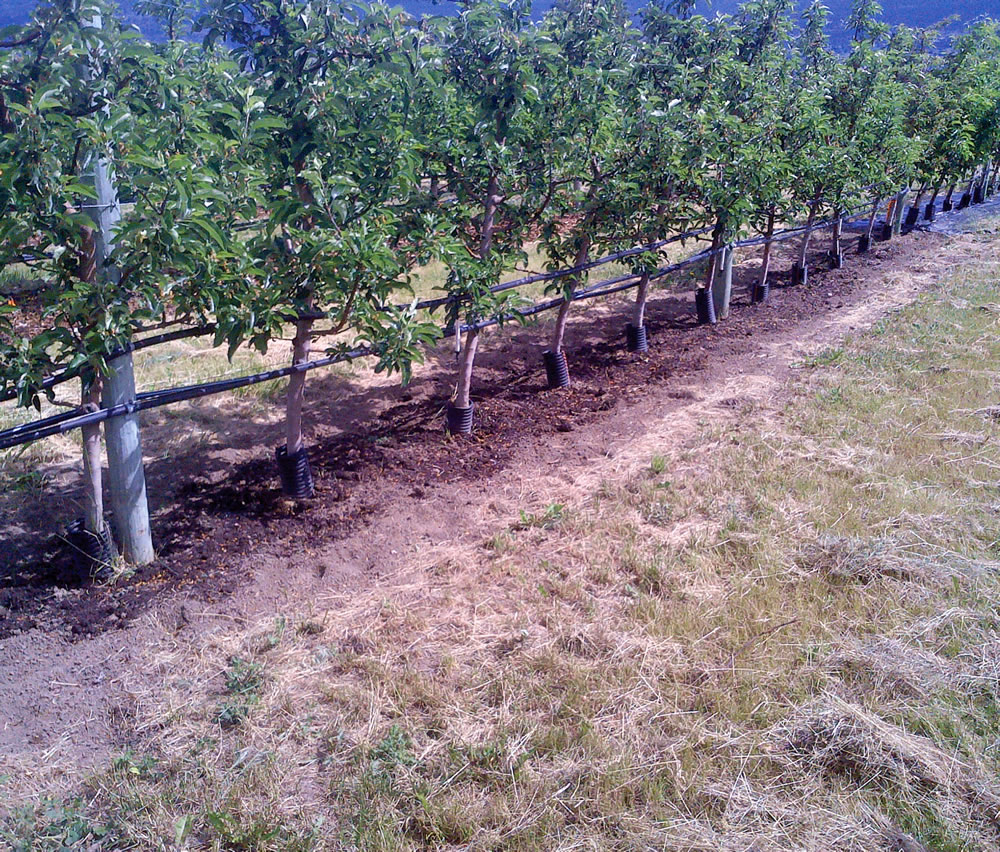Over a decade of research on application of compost to a variety of fruit crops shows range of benefits, including disease suppression and better crop use of nitrogen.
Peter Gorrie
BioCycle March/April 2016

An experiment with very young apple trees includes surface application of shredded paper mulch (foreground) and the City of Kelona’s Ogogrow compost, which is visible in the next plot. Photo by Tom Forge
Tom Forge, a research scientist with Agriculture and Agri-Food Canada, has been a leader in the studies, which sprang from his long-standing interest in improving the health of soils, particularly the coarse-textured soils that are often preferred for horticulture production but are prone to become depleted in organic matter and biological activity. When developing soil management plans, his focus, from the start, has been using compost to improve soil and increase productivity.
Perennial fruits are a small part of British Columbia’s economy, but the industry is vital in the province’s interior Okanagan Valley, which specializes in table and wine grapes as well as apples and cherries. Blueberries are an increasingly important crop on the Lower Mainland, the area around the Vancouver metropolitan area. In all, the province accounts for about 40 percent of Canada’s domestic fruit sales.
Compost faces different market conditions in each of the two regions where it is used. On the Lower Mainland, a flat, fertile river delta, it must compete — to date with only limited success — against the abundant low cost or free manure available from the many local poultry and cattle growers and dairy farms. In the Okanagan Valley, a dry area, hot in summer, where little livestock production takes place, fruit growers are seeking economical, effective sources of organic matter. They like compost but many don’t yet trust it and must still be convinced it’s worth the cost.
In both areas, fertilizers and other soil amendments are applied in two ways: With fruit trees, canes and vines already in the ground, it must be spread on the soil surface. When trees or plants are replaced, as they must be every few years due to disease issues or the need to transition to new varieties, the materials can be incorporated into the soil before new stock is planted. Boxes summarizing the trials and results are on pages 67-69.
Raspberry Cane Trials
Forge first began trials comparing compost with raw poultry manure as a replacement for mineral fertilizer on raspberry canes on the Lower Mainland (raspberry canes, Trial #1 box on p. 67). The compost, from poultry manure and greenhouse residues, was made at his research station but was similar to material that could be produced commercially.
The tests compared the performance of the compost against raw manure and chemical fertilizer, as well as untreated control plots. Compost and manure were applied each year at rates that were estimated to supply plants with the same amount of nitrogen they’d get from the standard annual chemical fertilizer application — anywhere from five to 10 tons per acre of compost. The amount depended on soil conditions, the amount of nitrogen in the material and its carbon:nitrogen (C:N) ratio, which varied from batch to batch and year to year. And because of those changing C:N ratios, how much of the nutrient would be available to the plants also varied.
The tests lasted only four years because of funding constraints, but plants treated with compost and manure produced similar yields, marginally better than those with fertilizer. Forge didn’t assess costs, fruit quality or the economic benefits of compost. The test period was too short for conclusive results on the economic side, he notes. But it was “long enough to see some benefits to the soil … a proof of concept” that compost applied at modest rates — just enough each year to meet the nitrogen requirements of the crop— could “provide other benefits to the cropping system.”
The plants’ root biomass increased while the soil gained organic matter and beneficial nematodes, which indicated enhanced biological activity. At the same time, the number of harmful root-lesion nematodes, which not only attack roots but also suggest the presence of other soil pathogens, decreased.
The tests also led to a plant-chemistry mystery. Nitrates are a preferred source of nitrogen for crops. Usually, the more of them floating freely in the soil, the more the plant can take up. Nitrates are also the form of nitrogen that is most readily leached from the soil. In Forge’s compost treatments, the total amount of nitrogen in the soil was enhanced, but the amount of nitrate was relatively low, which would have been expected to leave the crop deficient in nitrogen. However, the crop was not deficient. It appears the soil was supplying only the amount required, like the on-demand parts delivery favored at car assembly plants.
Why this happens isn’t yet understood, Forge notes. Some scientists speculate the plants signal they require nitrogen and the soil microbes, whose population is enhanced by the compost, release it, converting it to the form the crop prefers. Others suggest the compost simply acts as a slow-release fertilizer, changing how the soil releases nitrogen and the plants respond accordingly. In any case, this altered cycling has the advantage of reducing nitrate leaching and its potential contamination of groundwater.
Compost’s only downside: With its high phosphorus content, supplying enough to meet the plants’ nitrogen needs meant applying more phosphorus than the plants require. That situation would allow phosphorus to build in the soil, increasing the likelihood of runoff that could cause over-fertilization of surface water, noxious algae blooms and fish kills.
It’s not certain how long it takes for this to happen because soils have a widely varying capacity to adsorb phosphorus. The solution, Forge says, is to stop compost application every five to 10 years, to let the crop take up the excess phosphorus.

Compost was applied to apple trees in the Okanagan Valley (first row of trees above). Photo by Tom Forge
Additional Crop Trials
Forge also began tests on apple trees in the Okanagan Valley, working with collaborators Gerry and Denise Neilsen from the federal agricultural research station in the town of Summerland. The first trials involved surface applications of Ogogrow, a compost made from municipal biosolids and wood mill waste by the nearby City of Kelowna, alone or combined with shredded paper.
More recently, the team has evaluated other composts, including GlenGrow, made by Kelowna from leaf and yard residues and surface-applied to established grapevines and orchard trees. The results from those trials have generally been similar to those in the raspberry tests. “We generally see very positive changes in soil-health parameters, and sometimes suppression of root-lesion nematodes, but modest crop responses,” Forge explains. “With woody perennial crops it appears to take a while for changes in soil health to be manifest as changes in crop vigor.”
In 2008, back on the Lower Mainland, Forge began experiments on blueberries. The crop is typically grown with large quantities of sawdust mulch from nearby mills. The sawdust provides plenty of organic material, but little nitrogen. In fact, because of its high carbon content, which binds nitrogen, growers must apply far more chemical nitrogen than their crops need just to ensure they get enough. Eventually, that excess nitrogen could leach into groundwater or escape into the atmosphere as nitrous oxide, a potent greenhouse gas.
The tests aimed to see whether compost could be used instead of the sawdust and fertilizer combination on the blueberries. It turned out that composted manure contained more salt than the crop could tolerate. “We killed a lot of plants,” testing those materials in our preliminary trials, Forge adds. Composted leaf and yard residues, with less salt and lower pH — also crucial for blueberries — showed more promise.
But four years of trials demonstrated even this compost was detrimental to the crop when applied as a thick mulch, he says. “It suppressed growth,” likely because it raised the soil pH and still provided too many potassium salts, which, taken up by the plants, inhibited magnesium uptake, which is crucial for photosynthesis.
A treatment involving the application of compost over two inches of sawdust mulch, produced better results. The sawdust seemed to buffer the negative impacts of the compost, Forge notes. So there is still potential for compost to replace some of the sawdust and fertilizer used in blueberry production, but not all of it.
Reducing Plant Pathogens
Forge’s next work focused on a different compost application. Growers typically replace raspberry fruit trees and canes about every four to seven years, as root-lesion nematodes and other pathogens proliferate, damaging the plants and reducing yields. The same is true for high-density apple orchards but the time frame for replacement is closer to 10 years. To reduce pathogens following removal of the old plants, fumigants and sometimes poultry manure are incorporated into the soil, then new stock is planted.
Around 2010, the industry began getting “hints” that Canada’s Pesticide Management Regulatory Agency would be imposing new restrictions on use of fumigants. So Forge decided to test whether compost could deal with the pathogens. His research on use of compost to deal with replant disease complexes began with two sets of experiments, each covering two growing seasons, on Lower Mainland raspberries (Trial #2 box on p.68). They compared compost, applied at about 40 dry tons/acre, against two other treatments — raw poultry manure, applied at a similar rate, and fumigation — and untreated control plots.
The raspberry plants treated with compost or manure fared better than those on the control plots, but not as well as those with fumigants. Results were similar when it came to suppression of the root-legion nematodes and plant diseases. But while compost and manure looked equally effective as alternatives to fumigants, compost had a significant advantage: It contained much less readily available nitrogen, limiting the risk of leaching.
Back in Summerland, Forge began two new field experiments on cherry trees: one in the spring of 2014, the other, a year later. Several combinations are being tested, including:
• Compost incorporated into the planting zone at 25 tons/acre, with and without an application of bark mulch after the trees were planted. The trials employed two types: Big Horn Natural Compost, made from agricultural residues such as animal bedding and grape pomace by Big Horn Contracting Ltd., in Okanagan Falls; and Kelowna’s GlenGrow.
• Fumigation, with and without bark mulch.
• Untreated control plots, with and without bark mulch.
After the first growing season of the first experiment, trees in the fumigated soil were ahead of those with compost and the control plots, in terms of shoot growth and trunk diameter. But after the second full year of growth, those with compost had pulled equal to the fumigated trees.
Results for root lesion nematodes were even more dramatic. The fumigated plots had the fewest of them in the first year, but by the second they were faring worse than areas treated with compost, and even the control plots.
Forge plans to keep the cherry replant experiments going for another six or seven years. “That will give us the opportunity to document the full compost benefit,” he explains. “We suspect that at the beginning, fumigation will always be superior but, through time compost might catch up and maybe even surpass it in the long run. With fumigation you initially knock out the pathogens and create a great environment for very early root growth. But there’s no benefit after that. With compost, we don’t see immediate suppression of pathogens, but we see it over time.”
In addition, compost provides benefits, such as improved soil structure and moisture holding, that don’t come with fumigation. It’s not yet clear how long the compost impacts last. The anti-nematode and anti-fungal properties might weaken over time, although far more slowly than the fumigants’ benefits. Conversely, they might continue to regenerate.
Costs And Benefits
To date, Forge has done only a rough cost comparison on the cost-benefit of disease suppression treatments being tested. Fumigation costs about $1,000/acre. The cherry tree tests incorporated compost at 25 dry tons/acre, but only in the planting rows, which occupy about one-third of the total orchard. That means nine tons are applied on each acre. At just over $80/ton, the cost per acre is, therefore, $700.
“Fumigation and preplant incorporation of compost are in the same ballpark in terms of up-front cost,” Forge notes. “But we can’t do a true cost-benefit analysis until we start harvesting fruit after three years and beyond.”
In addition, compost costs vary widely, depending in part on how far the material must be hauled from producer to field and how much is applied. Also uncertain is whether any fumigants must be added even when compost is applied. It’s too soon for that result, too, which might significantly alter the calculation, he adds. “We need to do a few more trials.”
Okanagan growers’ response has been positive. “They’re willing to pay a modest price for compost,” Forge says. “I think their trust in the product will come with more systematic evaluation of compost, the dissemination of our results and further education.” Compost is in short supply in the valley, but that will improve since communities are developing plans for residential source separation and composting of organic wastes.
With the abundance of free or low cost manure, compost remains a tougher sell on the Lower Mainland. That might change: When applied at rates needed to really improve soil organic matter, manure generally provides more nutrients than crops can consume and, as a result, nitrates from it leach into groundwater, particularly during heavy fall rains. Measures to curb manure use are, for the most part, voluntary. But, Forge notes, these are under review. While there are no definite proposals yet, if use of manure is restricted, compost will become a more attractive option.
Peter Gorrie is a Contributing Editor to BioCycle.










